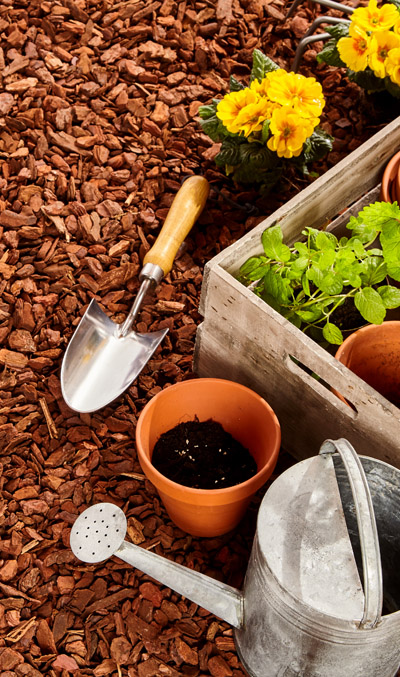Mulch Info

There are two types of mulches, organic and inorganic. Organic mulches include wood and bark chips, straw, grass clippings and seed hulls. Inorganic or inert mulches include weed-barrier fabrics, gravel and rock.
The ideal mulch does not compact readily. It does not hinder water and air movement into the soil, it is not a fire hazard, and it breaks down slowly. In addition, the ideal mulch is uniform in color, weed-free, attractive and does not blow away.
Selection
The selection of a mulch depends on its intended use. Consider the size of the area in relation to the cost of materials and availability (Table 1 in the "FULL ARTICLE"). Table 2 (In the "FULL ARTICLE") lists advantages and disadvantages of organic and inorganic mulches.
If appearance is the main goal, inorganic or inert mulches may be the best choice. If the main objective is soil improvement, consider an organic mulch that gradually breaks down. If the area is used primarily for annual flowers, it often is more practical to use a temporary organic mulch, such as composted leaves or grass clippings, that can be turned under each fall.
Mulches can be used to prevent soil erosion by wind and rain. In windy areas, gravel or rock mulch may be preferred over lightweight organic mulches. Any mulch that reduces the impact of raindrops will help reduce water erosion, just make sure the soil surface is entirely covered with mulch.
Black plastic (polyethylene) is not recommended as a mulch in landscape areas. Black plastic is impermeable therefore no oxygen exchange can occur in the soil. Lack of oxygen to the roots significantly reduces plant growth. Black plastic also prevents water penetration. If a weed barrier is needed, use landscape fabrics instead to allow water and oxygen exchange.
When to Apply Mulches
Mulches used to enhance appearance and control weeds may be applied at any time. If the mulch will be used to protect fall transplants by keeping soil temperatures above freezing longer into the fall (permitting better root growth), apply soon after transplanting. Reapply or refresh organic mulches after they have begun to break down. If the mulch is meant to reduce frost heave and delay spring growth, apply after the ground has frozen. This type of mulch often is used to protect small bulbs such as scilla and crocus and to prevent early emergence.
Depth of Mulches
Except where weed-barrier fabrics are used alone or in combination with chips, stones or other material, apply most mulches to a depth of 3 to 4 inches. Apply straw, dried leaves and similar materials to a depth of 4 to 6 inches. Some mulches, particularly straw and loose leaves, may harbor rodents so do not place them closer than 6 inches to the base of woody plants. When these types of mulches are placed next to the plant, rodents living in the mulch may chew the bark of the plants, girdling and eventually killing them. Mulches in contact with bark of woody plants may keep it too moist.
Preventing Nitrogen Deficiency
As organic mulches decompose, some of the soil nitrogen in contact with the mulch is used by the breakdown organisms. Consequently, nitrogen deficiency may occur. A sign of nitrogen deficiency is a yellowing, primarily of the lower leaves. When this occurs, add nitrogen fertilizers. For every 100 square feet of mulched area, add 2 pounds of a complete fertilizer, such as 10-6-4, or 1/4 pound of ammonium sulfate. Never use a “weed-and-feed” type of fertilizer in mulched areas.
Full Article